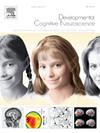行为抑制的学龄前儿童在与陌生人互动时,社交相关神经区域之间的连通性更强
IF 4.9
2区 医学
Q1 NEUROSCIENCES
引用次数: 0
摘要
社会行为抑制(BI),或对不熟悉的社会刺激反应的谨慎,是一种气质特征,当学龄前儿童出现时,预示着青春期的神经改变和焦虑症。目前的研究评估了学龄前与BI相关的神经功能。我们的样本根据母亲报告进行BI富集,包括59名学龄前儿童(54 %为女性,年龄= 3.7岁)。儿童通过学龄前版Lab-TAB中的陌生人方法范式与不熟悉的实验者进行互动,同时收集神经数据以测量对不熟悉的社会遭遇的神经反应。表现出更多社交bi相关行为的儿童在与陌生人互动时,多个社交相关神经区域之间的功能连通性更强,包括颞顶叶交界处、颞上回、内侧和外侧前额皮质。此外,在左右颞顶交界处有更强连通性的儿童在一年后有更大的母亲报告的焦虑症状。我们的研究结果表明,儿童早期可观察到的社交性脑损伤与不同的神经模式有关,这可能阐明了日后焦虑风险的生物标志物。本文章由计算机程序翻译,如有差异,请以英文原文为准。
Behaviorally inhibited preschoolers experience stronger connectivity among social-related neural regions while interacting with a stranger
Social behavioral inhibition (BI), or wariness in response to unfamiliar social stimuli, is a temperament trait that, when present in preschool-age children, predicts neural alterations and anxiety disorders by adolescence. The current study assessed neural functioning associated with BI during the preschool years. Our sample was enriched for BI based on mother report and included 59 preschool-age children (54 % female, Mage = 3.7 years). Children interacted with an unfamiliar experimenter via the Stranger Approach paradigm from the preschool version of Lab-TAB, and neural data were collected simultaneously to measure neural response to an unfamiliar social encounter. Children who exhibited more social BI-related behaviors experienced stronger functional connectivity between multiple social-related neural regions, including the temporoparietal junction, superior temporal gyrus, and medial and lateral prefrontal cortex while interacting with a stranger. Additionally, children who experienced stronger connectivity between the right and left temporoparietal junction had greater mother-reported anxiety symptoms one year later. Our results suggest that observable social BI during early childhood is associated with distinct neural patterns, which may elucidate biomarkers that underlie risk for later anxiety.
求助全文
通过发布文献求助,成功后即可免费获取论文全文。
去求助
来源期刊

Developmental Cognitive Neuroscience
NEUROSCIENCES-
CiteScore
7.60
自引率
10.60%
发文量
124
审稿时长
6-12 weeks
期刊介绍:
The journal publishes theoretical and research papers on cognitive brain development, from infancy through childhood and adolescence and into adulthood. It covers neurocognitive development and neurocognitive processing in both typical and atypical development, including social and affective aspects. Appropriate methodologies for the journal include, but are not limited to, functional neuroimaging (fMRI and MEG), electrophysiology (EEG and ERP), NIRS and transcranial magnetic stimulation, as well as other basic neuroscience approaches using cellular and animal models that directly address cognitive brain development, patient studies, case studies, post-mortem studies and pharmacological studies.
 求助内容:
求助内容: 应助结果提醒方式:
应助结果提醒方式:


